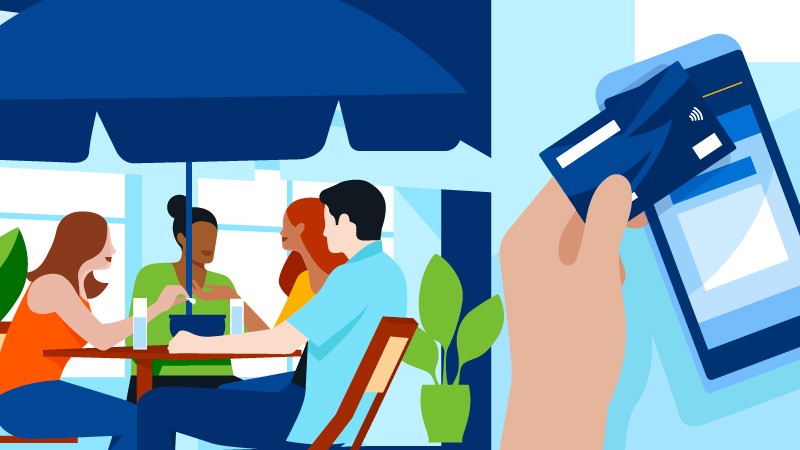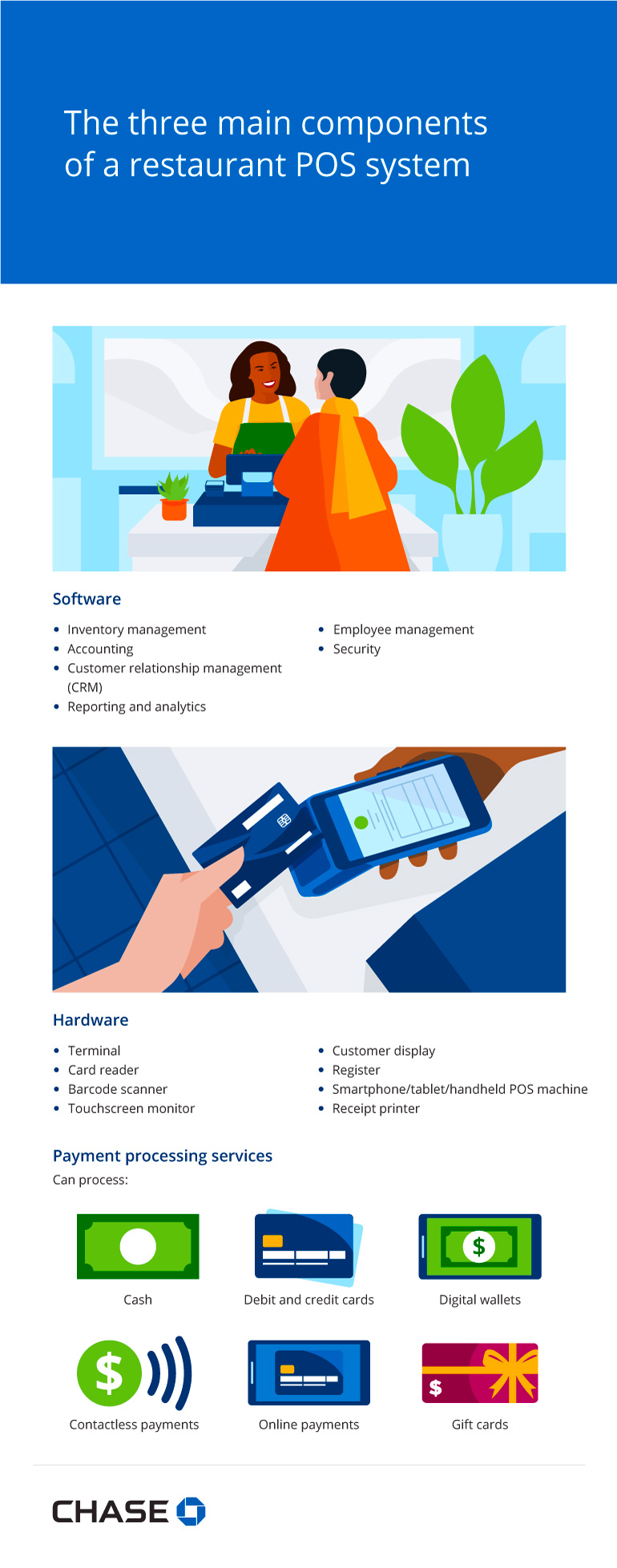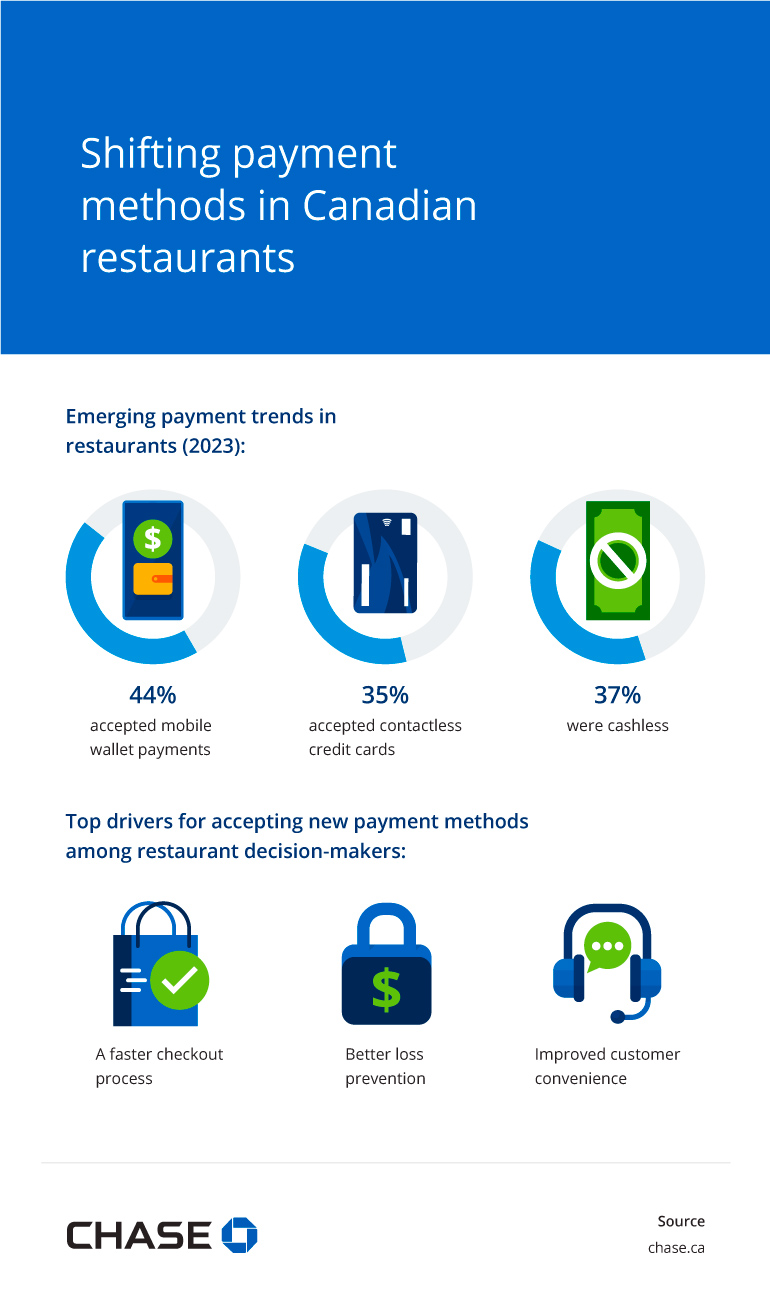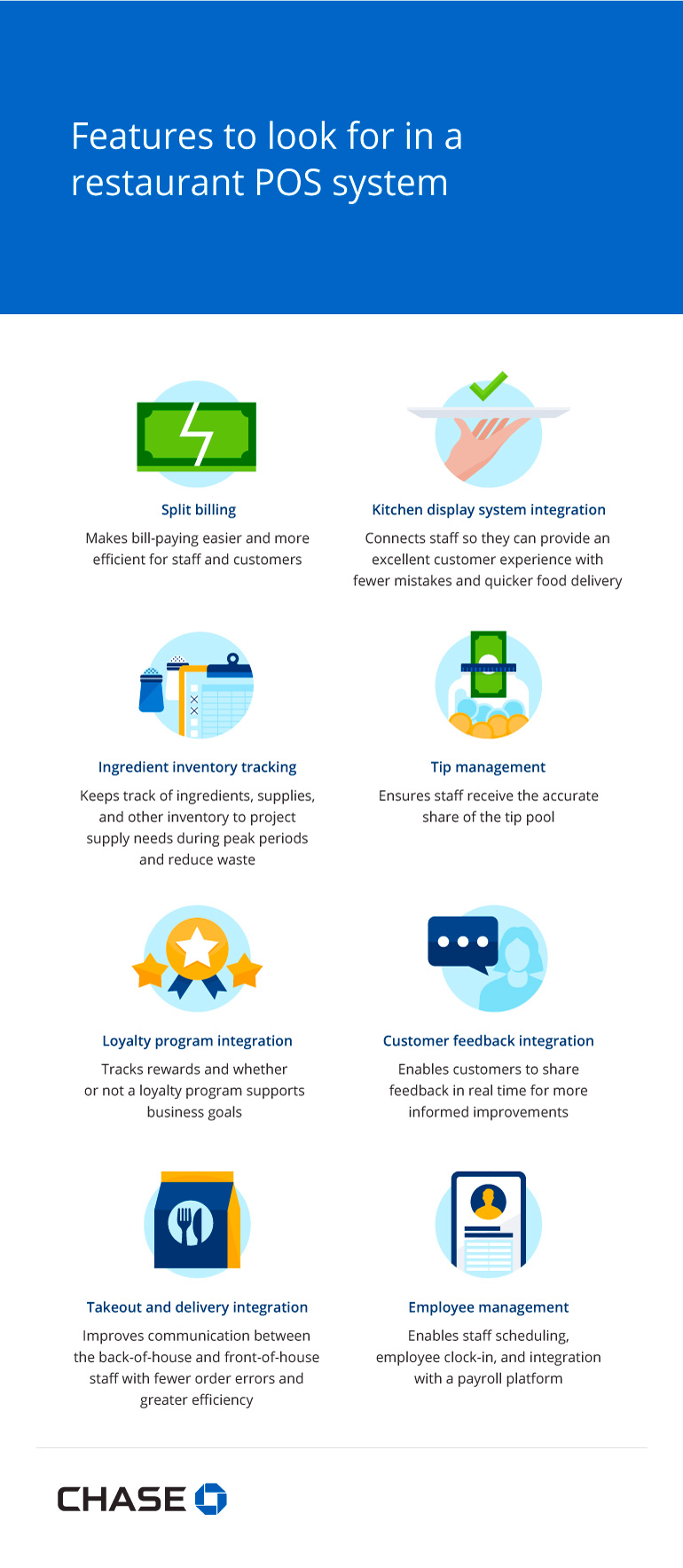What to look for in a POS system for your restaurant

In running your restaurant, you know how important it is to get every single detail right — from the ambiance to the delectable dishes featured on your menu. So when it’s time for customers to pay their bill, it’s no wonder you’d want to provide them with a quick, easy, and seamless experience.
A point-of-sale (POS) system is primarily used to assist in processing customer payments. A sophisticated POS system may also boast restaurant-specific features to help you run a smooth operation. For instance, it may include the ability to manage tables, reservations, takeout and delivery orders, employees, inventory, marketing campaigns and platforms, loyalty programs, e-commerce, and more.
If you operate one of the 85,000+ restaurants in Canada, it’s worth considering a POS system. Here, we'll take a deep dive into the components of a restaurant POS system, how to gauge what you need, and how to choose the best system for you.

Software
- Inventory management
- Accounting
- Customer relationship management (CRM)
- Reporting and analytics
- Employee management
- Security
Hardware
- Terminal
- Card reader
- Barcode scanner
- Touchscreen monitor
- Customer display
- Register
- Smartphone/tablet/handheld POS machine
- Receipt printer
Payment processing services
Can process:
- Cash
- Debit and credit cards
- Contactless payments
- Digital wallets
- Online payments
- Gift cards
What are the three components of a restaurant POS system?
A POS system needs a trifecta of software, hardware, and payment processing services to operate efficiently.
Software
POS software can include a host of different components, such as:
- Inventory management
Keeps track of ingredients, supplies, equipment, merchandise, and other inventory to run your restaurant - Accounting
Tracks financial data — such as sales, fees, bank deposits, and purchases — and automates sales and inventory reports - Customer relationship management (CRM)
Stores customer contact information and keeps tabs on customer habits and purchase patterns - Reporting and analytics
Helps guide decision-making with data on sales, customer behaviour, and more - Employee management
Facilitates employee time-tracking, scheduling, and time-off requests - Security
Protects personal and financial data and ensures customers can safely make purchases
Hardware
Along with the software to help process transactions and data, POS systems also require some or all of the following physical components:
- Terminal
A tablet, cash register, kiosk POS, self-service kiosk, or mobile app used to process transactions - Smartphone/tablet/handheld POS machine
Small, wireless mobile POS devices often used in place of a cash register or countertop POS terminal - Card reader
A device that enables you to accept credit or debit card payments - Barcode scanner
An optical device, also known as a barcode reader or price scanner, used to read merchandise barcodes and send data to your POS - Touchscreen monitor
A touch-enabled screen on a tablet or handheld POS system used to input orders, check inventory, and clock staff in and out - Customer display
A screen that shows customers their order information and sends purchasing prompts when they check out - Receipt printer
A countertop or mobile device used to print out physical receipts
Payment processing services
Besides software and hardware, a POS system also includes payment processing services and ensures safe and efficient processing of electronic payments, including cash, credit cards, debit cards, prepaid/gift cards, and digital or contactless wallets. If you accept online orders, online payments fall under this umbrella, too.
Depending on your type of restaurant and how it runs, you might rely more on certain aspects and features of a POS system than others. For example, if you have a sit-down food establishment where customers order at the counter, you may need a countertop system. If you operate a fast-casual restaurant, you may lean more on a mobile system. And if you have a food truck, you may find a handheld POS system or phone and contactless payments most useful.

Emerging payment trends in restaurants (2023):
- 44% accepted mobile wallet payments
- 35% accepted contactless credit cards
- 37% were cashless
Top drivers for accepting new payment methods among restaurant decision-makers:
- A faster checkout process
- Better loss prevention
- Improved customer convenience
Source:
Do you need a POS system for your restaurant?
Across all industries, POS transactions are on the rise. According to a 2023 Payments Canada report (PDF), between 2021 and 2022, there was a year-over-year increase in POS transactions across all payment methods.
That boost in POS system use aligns with a strong demand among consumers. Additional research from Payments Canada reveals that more than one third of Canadian consumers are curious about trying out fresh POS services to enhance their payment experience. These methods may include one-click pay, pay-and-go payments, and invisible payments and scan, which are all features that can be integrated into a restaurant's POS system.
Our 2024 State of Canadian Payments report shows restaurants are adopting new payment options. In 2023, 44% of restaurants accepted mobile wallet payments and 37% operated in a cashless environment, reflecting the shift toward advanced POS features.
Notable benefits of a well-equipped POS system
- Increased operational efficiency
From better inventory and staff management to detailed analytics and tracking, running a tighter operation can lead to higher profits and significant savings. - Improved sales tracking
More detailed, comprehensive, and real-time sales data can help you make quicker, more informed decisions for your restaurant. - Reduced theft and fraud
POS systems include an array of security and financial tracking features that can help minimize theft and fraud. This may include data encryption, fraud detection, antivirus software, transaction security, and continuous monitoring. - Better customer experience
With a great POS system, your patrons can enjoy safe and speedy transactions and choose from a wealth of payment options. Plus, with certain systems, you can offer your restaurant-goers an interactive menu for simple tableside ordering. - Better communication
A POS system can send automated messages to customers, such as order confirmation, delivery notifications, and requests for feedback and reviews. Customer feedback can facilitate communication with your staff and patrons while helping you make smart choices for your menu and operations. - The ability to customize and scale
POS systems can offer tailored solutions to meet your restaurant's specific needs. Additionally, they can accommodate your growth as you increase customer flow or even open new locations.
What to be aware of when using a POS system in a restaurant
While a host of POS system benefits can help you improve the efficiency and bottom line of your restaurant business, be sure to factor in these considerations:
- Additional costs
Expect to invest in setup, maintenance, and equipment costs from the get-go, in addition to ongoing payment processing fees. These fees vary by processor and type of payment and can quickly add up. The good news: The Canadian government lowered the domestic consumer interchange rates for small- and medium-sized businesses from an annual effective rate of 1.5% to 1.4% per transaction over a period of five years. - Choosing the wrong POS system
Without due diligence, you might choose a POS system that isn't the best fit for your restaurant. You can avoid this problem by taking the time to assess your specific needs and researching plenty of options. - Security
Cybercriminals might breach your network or device and access sensitive, private data including customer information. Thankfully, POS systems typically offer several important security features — like data encryption, tokenization, and two-factor authentication — to help minimize your risk. - Maintenance
Malfunctions in your software and hardware could mean hiccups in your operations and loss of business. With that said, selecting a POS system with great customer support, keeping up routine hardware maintenance, updating software, and regularly training staff can help prevent system breakdowns.
While these potential disadvantages can arise when you use a restaurant POS system, the advantages often outweigh the disadvantages. So while setup and maintenance costs can add up, the financial benefits of using a POS system include stronger inventory management, the ability to offer your customers the payment methods they want to use, and real-time tracking.

- Split billing
Makes bill-paying easier and more efficient for staff and customers - Kitchen display system integration
Connects staff so they can provide an excellent customer experience with fewer mistakes and quicker food delivery - Ingredient inventory tracking
Keeps track of ingredients, supplies, and other inventory to project supply needs during peak periods and reduce waste - Tip management
Ensures staff receive the accurate share of the tip pool - Loyalty program integration
Tracks rewards and whether or not a loyalty program supports business goals - Customer feedback integration
Enables customers to share feedback in real time for more informed improvements - Takeout and delivery integration
Improves communication between the back-of-house and front-of-house staff with fewer order errors and greater efficiency - Employee management
Enables staff scheduling, employee clock-in, and integration with a payroll platform
How to choose the best POS system for your restaurant
When searching for the best POS system for your restaurant, you'll want to look at all the features, benefits, and compatibilities of a system. Of course, different features will matter more to you and your business. The most important restaurant-specific features will come down to your type of restaurant, how big it is, how it runs, and your preferences. These features include:
- Split billing
By offering an intuitive way to split bills, you’ll make the bill-paying process easier and more efficient for your staff and customers. - Kitchen display system integration
Integrating crucial back-of-house tools — like a seamless kitchen display system — can help keep your staff connected and able to provide the best customer experience possible with fewer mistakes and quicker food delivery. - Ingredient inventory tracking
Precise tracking of your ingredients, supplies, and other inventory can reduce waste and project supply needs during peak periods. - Tip management
Accurate tip management can ensure your staff receives the right share of the tip pool and your bookkeeping stays accurate. - Loyalty program integration
Integrating a loyalty program can help you keep better track of rewards and whether or not your program helps you meet your business goals. - Customer feedback integration
Your POS system can also enable customers to share feedback in real time so you can make more informed improvements and keep guests coming back. - Takeout and delivery integration
Using your POS as a one-stop shop for takeout and delivery can help both the back of house and front of house work in tandem with fewer errors and greater efficiency while juggling dine-in and dine-out orders. - Employee management
A robust POS system enables staff scheduling, employee clock-in, and integration with a payroll platform.
Conclusion
Whether you operate seasonally or all year long, a restaurant POS system can help enhance your business operations, boost profits, and bring in more customers. Before making an investment, make sure you put in the time to choose the right system for your needs. If you’d like to learn more about payment solutions for restaurant owners, visit our resource articles, check out our original research report, The 2024 Canadian State of Payments, and get started with Chase Payment Solutions.